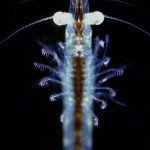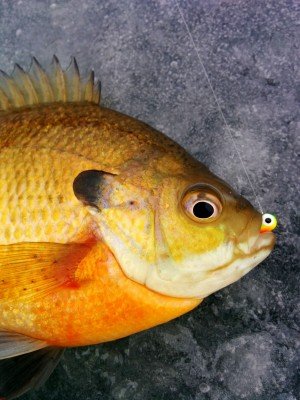7 Ice Fishing Facts To Help You Catch Early Season Panfish
Are those early ice fishing panfish eluding you? Have you ever wondered why crappies and sunfish, during early season ice fishing, aren't in the same locations as they were the previous year? Maybe you had an experience where you were on an awesome bite one day and the next everything was gone.
What happened?
Here are some clues and a number of facts that may help you. Factor them into your ice fishing equation, and maybe these pieces of the puzzle will make your ice fishing season more productive and enjoyable.
- When ice fishing, crappies, sunfish and blue gills will primarily feed on zooplankton. Crappies have large baskets for mouths with finely evolved gill rakers to trap the plankton. That is why you often catch them in the evening, because they just have to swim and strain. Bluegills have excellent eyesight for daytime use and, along with their smaller mouths, that is why you rarely catch sunfish after dark.
 Zooplankton
generally rise to the surface during low light levels to feed on
light-loving phytoplankton, and then drop back to the bottom during
brighter periods. This is important to understand, because there are a
number of things that affect light levels. Dusk and dawn are generally
an important time for massive zooplankton movement because of their
instinctive behaviours. They are generally slow moving, so your window
of opportunity can be longer, depending on the types of zooplankton
moving below your water column.
Zooplankton
generally rise to the surface during low light levels to feed on
light-loving phytoplankton, and then drop back to the bottom during
brighter periods. This is important to understand, because there are a
number of things that affect light levels. Dusk and dawn are generally
an important time for massive zooplankton movement because of their
instinctive behaviours. They are generally slow moving, so your window
of opportunity can be longer, depending on the types of zooplankton
moving below your water column.- Sharper breaks into deeper water will provide low light faster as the sun passes by. If you've ever been traveling between skyscrapers you've likely seen this effect. Panfish instinctively react to this, and utilize sharp breaks during ice fishing season because of the extended feeding opportunities, with plankton rising earlier in those spots. Panfish expend less effort moving out from the break as the dark shadow slowly falls further away from the sharper breaks. Utilize this knowledge and drill holes in the direction the shadow will fall, so you can move out as the panfish move further away from the sharp break.
- Temperature varies from year to year. If everything else is the same, the longer it stays warm the more crappies and blue gills will stay shallow around green weeds. If the ice comes later, the panfish will generally be shallower later. But remember daylight gets shorter so there is less energy feeding the lake and weeds each passing day until December 21st in the northland.
- The time between ice formation and the first significant snowfall will determine light penetration, as well as the ability of ice to form a seal on the lake. Heavy snow will push thin early ice down, causing a flow of water on top of the ice. Snow is like an insulator and will keep water on top of the ice for extended periods, if not an entire season. The water, which is heavier than ice, will keep seeping downward and can keep large cracks and pockets in the ice open. The wind blows, forcing the snow and ice down with a plunging effect. This does move plankton around. While you may have low light, causing fish to seek deeper water where untouched plankton starts migrating up to find light, you also have water being pushed around, causing warmer pockets where plankton and fish take advantage of the extra energy in those warmer pockets. Light is also lower, allowing zooplankton to stay up feeding on phytoplankton longer. Sunset and Sunrise's low light effects will be muted, and zooplankton's migration time up and down the water column is generally extended. So find water a degree or two warmer than the surrounding area and you may be in for a treat… BUT the sledding can be very tough.
 You
can easily see some zooplankton - like copepods - and some you can
totally miss or hardly see at all. If you can match the larger little
animals (zooplankton) swimming under the ice, you can take advantage of
crappie and bluegills' tendency to target a slightly larger meal, that
more resembles what they are currently feeding on. It also means you may
want to try and mimic their movement pattern (jigging) to induce more
bites. Study them and how they move, especially if they are up swimming
in your ice holes.
You
can easily see some zooplankton - like copepods - and some you can
totally miss or hardly see at all. If you can match the larger little
animals (zooplankton) swimming under the ice, you can take advantage of
crappie and bluegills' tendency to target a slightly larger meal, that
more resembles what they are currently feeding on. It also means you may
want to try and mimic their movement pattern (jigging) to induce more
bites. Study them and how they move, especially if they are up swimming
in your ice holes.- During daylight hours, most zooplankton will be near, on or in the bottom of the lake. If you can identify the types of zooplankton your target species is after, you can try to copy stragglers. Every species has them. I'm betting you've often heard folks tell you to pound the bottom with your lure. Panfish come to check it out for the zooplankton that have been stirred up and dislodged for an easy meal.


